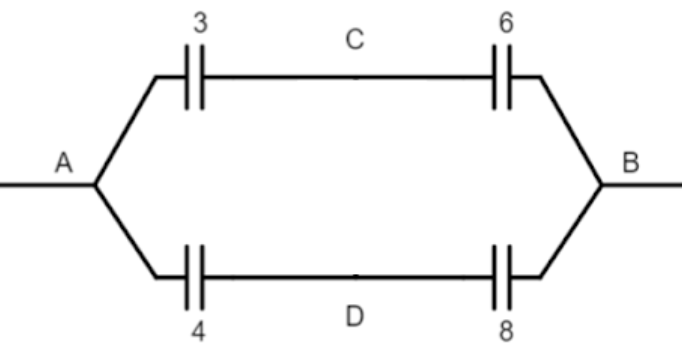Answer
397.5k+ views
Hint: We will find the electric potential at points A, B, C, and D using the formula, and then we will find the charges stored on each of the capacitors. The relation of the charge stored on the capacitors along the same line will be the same and we will use this to find the effective capacitance.
Formula used:
The relation between capacitance-voltage across the capacitor and charge stored in the capacitor
$Q=CV$.
Complete step-by-step solution:
Let \[{{Q}_{2}},{{Q}_{3}},{{Q}_{4}},{{Q}_{6}},{{Q}_{8}}\] be the charge stored on the capacitors of 2 μF, 3 μF, 4 μF, 6 μF and 8 μF respectively. Then their values will be
\[\begin{align}
& {{Q}_{2}}=2({{V}_{D}}-{{V}_{C}}) \\
& {{Q}_{3}}=3({{V}_{A}}-{{V}_{C}}) \\
& {{Q}_{4}}=4({{V}_{A}}-{{V}_{D}}) \\
& {{Q}_{6}}=6({{V}_{C}}-{{V}_{B}}) \\
& {{Q}_{8}}=8({{V}_{D}}-{{V}_{B}}) \\
\end{align}\]
As the capacitors of 3 μF and 6 μF lie on the same line they will have the same charge on them. Similarly, for the capacitors of 4 μF and 8 μF.
\[\begin{align}
& {{Q}_{3}}={{Q}_{6}}\Rightarrow 3({{V}_{A}}-{{V}_{C}})=6({{V}_{C}}-{{V}_{B}})\Rightarrow ({{V}_{A}}-{{V}_{C}})=2({{V}_{C}}-{{V}_{B}})\Rightarrow 3{{V}_{C}}={{V}_{A}}+2{{V}_{B}} \\
& {{Q}_{4}}={{Q}_{8}}\Rightarrow 4({{V}_{A}}-{{V}_{D}})=8({{V}_{D}}-{{V}_{B}})\Rightarrow ({{V}_{A}}-{{V}_{D}})=2({{V}_{D}}-{{V}_{B}})\Rightarrow 3{{V}_{D}}={{V}_{A}}+2{{V}_{B}} \\
\end{align}\]
As we can see above, the potentials as points C and D are the same which means that no current will flow between them and through the 2 μF capacitor. So, it will be like there is no line connecting the points C and D. So now the capacitors of 3 μF and 6 μF will be in series on the same branch which will be parallel to another branch which capacitors of 4 μF and 8 μF will be in series as in the figure.

The capacitance of the branches in series will be\[\dfrac{1}{\dfrac{1}{3}+\dfrac{1}{6}}=2\] μF and \[\dfrac{1}{\dfrac{1}{4}+\dfrac{1}{8}}=\dfrac{8}{3}\] μF. These two will be in parallel to each other so the effective capacitance will be $\dfrac{8}{3}+2=\dfrac{14}{3}$ μF. Hence, the correct option will be B, i.e. $\dfrac{14}{3}$μF.
Note: Take care when solving this question. Although the potential at points C and D will be the same, there won’t be any current flowing between them. There can be a common mistake of considering that the points C and D will be connected to each other. That way we will get the same answer, but that is not what actually happens.
Formula used:
The relation between capacitance-voltage across the capacitor and charge stored in the capacitor
$Q=CV$.
Complete step-by-step solution:
Let \[{{Q}_{2}},{{Q}_{3}},{{Q}_{4}},{{Q}_{6}},{{Q}_{8}}\] be the charge stored on the capacitors of 2 μF, 3 μF, 4 μF, 6 μF and 8 μF respectively. Then their values will be
\[\begin{align}
& {{Q}_{2}}=2({{V}_{D}}-{{V}_{C}}) \\
& {{Q}_{3}}=3({{V}_{A}}-{{V}_{C}}) \\
& {{Q}_{4}}=4({{V}_{A}}-{{V}_{D}}) \\
& {{Q}_{6}}=6({{V}_{C}}-{{V}_{B}}) \\
& {{Q}_{8}}=8({{V}_{D}}-{{V}_{B}}) \\
\end{align}\]
As the capacitors of 3 μF and 6 μF lie on the same line they will have the same charge on them. Similarly, for the capacitors of 4 μF and 8 μF.
\[\begin{align}
& {{Q}_{3}}={{Q}_{6}}\Rightarrow 3({{V}_{A}}-{{V}_{C}})=6({{V}_{C}}-{{V}_{B}})\Rightarrow ({{V}_{A}}-{{V}_{C}})=2({{V}_{C}}-{{V}_{B}})\Rightarrow 3{{V}_{C}}={{V}_{A}}+2{{V}_{B}} \\
& {{Q}_{4}}={{Q}_{8}}\Rightarrow 4({{V}_{A}}-{{V}_{D}})=8({{V}_{D}}-{{V}_{B}})\Rightarrow ({{V}_{A}}-{{V}_{D}})=2({{V}_{D}}-{{V}_{B}})\Rightarrow 3{{V}_{D}}={{V}_{A}}+2{{V}_{B}} \\
\end{align}\]
As we can see above, the potentials as points C and D are the same which means that no current will flow between them and through the 2 μF capacitor. So, it will be like there is no line connecting the points C and D. So now the capacitors of 3 μF and 6 μF will be in series on the same branch which will be parallel to another branch which capacitors of 4 μF and 8 μF will be in series as in the figure.

The capacitance of the branches in series will be\[\dfrac{1}{\dfrac{1}{3}+\dfrac{1}{6}}=2\] μF and \[\dfrac{1}{\dfrac{1}{4}+\dfrac{1}{8}}=\dfrac{8}{3}\] μF. These two will be in parallel to each other so the effective capacitance will be $\dfrac{8}{3}+2=\dfrac{14}{3}$ μF. Hence, the correct option will be B, i.e. $\dfrac{14}{3}$μF.
Note: Take care when solving this question. Although the potential at points C and D will be the same, there won’t be any current flowing between them. There can be a common mistake of considering that the points C and D will be connected to each other. That way we will get the same answer, but that is not what actually happens.
Recently Updated Pages
Basicity of sulphurous acid and sulphuric acid are

Assertion The resistivity of a semiconductor increases class 13 physics CBSE

Three beakers labelled as A B and C each containing 25 mL of water were taken A small amount of NaOH anhydrous CuSO4 and NaCl were added to the beakers A B and C respectively It was observed that there was an increase in the temperature of the solutions contained in beakers A and B whereas in case of beaker C the temperature of the solution falls Which one of the following statements isarecorrect i In beakers A and B exothermic process has occurred ii In beakers A and B endothermic process has occurred iii In beaker C exothermic process has occurred iv In beaker C endothermic process has occurred

The branch of science which deals with nature and natural class 10 physics CBSE

What is the stopping potential when the metal with class 12 physics JEE_Main

The momentum of a photon is 2 times 10 16gm cmsec Its class 12 physics JEE_Main

Trending doubts
Difference Between Plant Cell and Animal Cell

Difference between Prokaryotic cell and Eukaryotic class 11 biology CBSE

Fill the blanks with the suitable prepositions 1 The class 9 english CBSE

Change the following sentences into negative and interrogative class 10 english CBSE

Summary of the poem Where the Mind is Without Fear class 8 english CBSE

Give 10 examples for herbs , shrubs , climbers , creepers

Write an application to the principal requesting five class 10 english CBSE

What organs are located on the left side of your body class 11 biology CBSE

What is the z value for a 90 95 and 99 percent confidence class 11 maths CBSE




